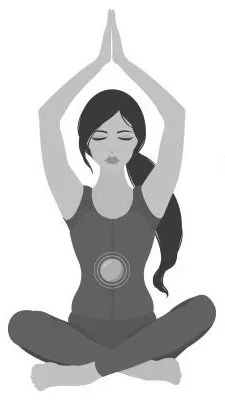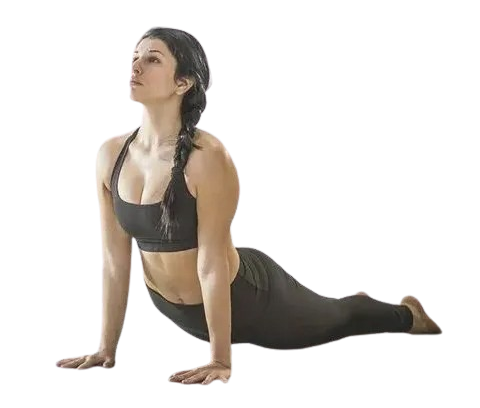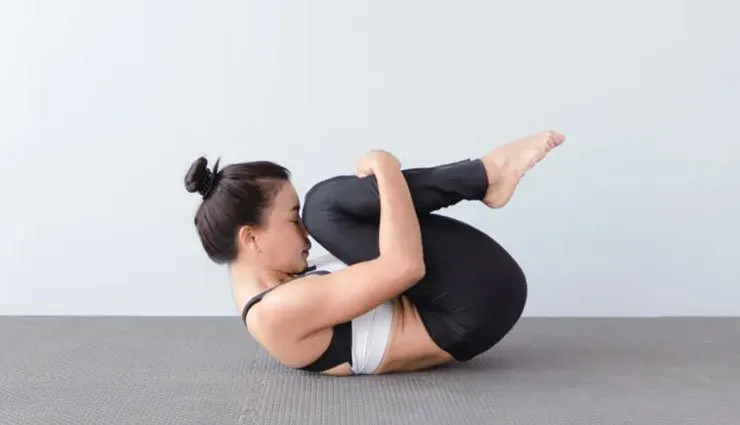On This Page
Different Yoga Modules That Can Be Used as Remedial Therapy to Better Manage the Symptoms of Crohn’s Disease Are as Follows:
- Regulation of Manipura Chakra
- Balancing of Pancha Kosha
- Agnisara Kriya, Laghu Shankha Prakshalana, Kapalbhati (Shodhana Karma)
- Yoga module that particularly focuses on the abdominal region and helps to relieve Crohn’s diseases
- Specific Asana for Crohn’s diseases
- Mudra and Bandhas
- Yoga Nidra
Regulation of Manipura Chakra
Manipura Chakra is correlated with the coeliac plexus and small plexuses surrounding it. Manipura Chakra lies in the vicinity of Nabhi (umbilicus). In the vicinity of Nabhi, the coeliac plexus is the largest major autonomic plexus that surrounds the coeliac artery and the root of the superior mesenteric artery. According to classical texts of Yoga and Ayurveda, Manipura Chakra is the Sthana (seat) of Samana Vayu which helps in regulating the proper distribution of food, drink, blood, and inhaled material in the body. By regulating Manipura Chakra motility of the Gastrointestinal tract is balanced by regularizing the contraction and relaxation of intestinal muscle fibers. From this, we can conclude regulation of Manipura Chakra affects physiology and pathology like Crohn’s disease of abdominal organs. Regulation of Manipura Chakra produces both physical and psychological effects.
To Know more about the Regulation of Manipura Chakra, Click here.

Balancing of Pancha Kosha by Yoga therapy
The Panch Kosha concept was described by Taittiriya Upanishads. In this Upnishada Panch Kosha is defined as inter-twined layers of human existence. The Panchkosha concept is very useful in understanding the modern concept of Psychosomatic disorders. Pancha Kosha is as follows:
- Anaamaya Kosha (physical body)
- Pranaamaya Kosha (vital life force)
- Manomaya Kosha (thoughts)
- Vijnanamya Kosha (intellect of mind)
- Anandmaya Kosha (harmony, Awareness)
Concept of Pancha Kosha to understand Crohn’s disease and its remedy through Yoga
As we know that Crohn’s disease is affected by lifestyle, stress, etc, and is considered Adhi Vyadhi (that originates due to conflicts in mind). Due to stress factors, the Varista Prana (vital life force) is affected which by balancing the breath causes dysfunction in Pancha Kosha (five channels of life force). The autonomic nervous system is disturbed due to this which heightened bowel contractility. This result vitiates Samana Vayu which is responsible for balancing Prana, Apana Vayu, and responsible for digestion. Vitiation of Samana Vayu results in Ajirna, Atijirna, and Kujirna (non-digestion, over digestion, and wrong digestion). All this results in various abdominal problems like epigastric pain, hyperacidity, gastric reflux, etc. Increased peristaltic movements lead to Atisara and excess saccular contraction leads to constipation which ultimately results in Crohn’s disease. This panch kosha disturbance mainly Manomaya, Anamaya, and Pranamaya kosha can be co-related with stress-induced brain-gut axis dysfunction. The yoga module mentioned in this article can be used to balance Panch Kosha.
Pancha Kosha, associated disorders, and interventions
| Pancha Kosha | Associated disorders | Intervention |
| Anamaya Kosha | Digestive disorders | Various Asanas like Vajra Asana, Bhujanagasana, and Padmasana and their modifications are practiced along with Anuloma, Viloma, Nadi Shodhana, etc. |
| Pranamaya Kosha | Respiratory disorders and cardiac disorders | Om Chanting along with various Asanas like Vajra Asana, Simha Asana, Paschimouttana Asana, Nadi Shodhana, Surya Namskara, Ujjayi Pranayama, etc. |
| Manomaya Kosha | Psychological, mental, and endocrinal disorders | Meditation, Nadi Shodhana, Relaxative and cultural Asana. |
| Vijanamaya Kosha | Psychological, mental, endocrinal disorders, and various other disorders | Deep Breathing, Kumbhaka (Retention), Meditation, Dharana, and Pratyahara Yogic practice |
| Anandamaya Kosha | Various disorders hinder the overall expansion of energy, life, happiness, etc | The rectification of disorders related to Manomaya, Anamaya Kosha, etc leads to proper channelizing of Anandamaya Kosha.Practice or intervention mentioned to various Koshas are used as per the identification of cases for Anadmaya Kosha. |
For more information on Pancha Kosha theory, click here.
Shodhana Karma Beneficial in Crohn’s Diseases
Shodhana means the cleansing process or purification process. It is popularly known as Shat Karma or Shodhana Karma in Gheranda Samhita and Hath Yoga Pardipika. Shat Karma is a set of six cleaning practices that helps to cleanse the important areas of the human body. It is done before other procedures like Asana, Mudra, etc. Shodhana Karma is described in Hath Yoga Pardipika as an optional Karma and also it was not mentioned under the limbs of Hatha Yoga. While in Gheranda Samhita, Shodhana Karma is one of the seven limbs of Ghata Yoga (Sapta Shadhnam). In Gheranda Samhita, Shodhana Karma (Nirmanu Nadi Shodhana) is considered the Method of Nadi Shodhana (G. S. V/ 36, 37).
What is Shat Karma or Shodhana Karma?
Gheranda Samhita, Prathama Updesha, 12
धौतिर्वस्तिस्तथा नेति लौलिकीत्राटकं तथा।
कपालभातिश्चैतनि षट कर्माणि समाचरेत्।।
शोधन छ: प्रकार के होते हैं- धौति, वस्ति, नेति, लौलिकी, त्राटक और कपालभाति।
इन धौति आदि छः प्रकार के कर्मयोगों का साधक को आचरण अर्थात् सम्यक् रूपेण अभ्यास करना चाहिये।
There are six types of purification – Dhauti, Vasti, Neti, Lauliki, Tratak and Kapalbhati. The practice of these six types of dhauti etc., should be practiced properly.
To Know more about the Regulation of Shata Karma or Shodhana Karma, click here.
The main Shodhana Karma beneficial for Crohn’s disease are as follows:
Dhouti Karma
This cleansing Karma is used to train the mind and body for voluntary control over the anti-peristaltic or peristaltic movement of the digestive system. Dhoti Karma helps in the cleansing of the stomach and digestive tract.
Different types of Dhauti Karma mentioned are mentioned in Gheranda Samhita an Hath Yoga Pradipika.
Four types of Dhauti Karma have been mentioned in Gheranda Samhita
Gheranda Samhita, Prathama Updesha, 13
अन्त धौति र्दन्तधौति हृद धौति मूलशोधनम्।
धौतिं चतुर्विधां कृत्वा घटं कुर्वन्तु निर्मलम्।।
धौति चार प्रकार की कही गयी है- अंत धौति, दन्तधौति, हृद धौति, एवं मूलशोधन। इस चतुष्प्रकारक धौति द्वारा का साधन करना चाहिये।।
- Antra Dhauti
- Danta Dhauti
- Hrida Dhauti
- Mula Shodhana
Antra Dhouti: Gheranda Samhita, Pratham Updesha, 14
वात सारं वारि सारं वह्नि सारं बहिष्कृतं।
घटस्य निर्मलार्थाय अंतरधौतिश्चतुर्विधा।।
अन्त धौति चार प्रकार की होती है- वातसार, वारि सार, वह्नि सार और बहिष्कृत।
चार प्रकार वाली इस अन्तर्धौति के द्वारा शरीर को निर्मल बनाया जाता है।
Antra Dhouti is the procedure of internal cleansing of the body. It is further four types i.e.:
- Vata Sara Antra Dhouti
- Vaari Sara Antra Dhouti
- Vahni Sara Antra Dhouti
- Bahishkrit Antra Dhouti
The above-mentioned four types of Antra Dhoutis, Vata Sara, and Vahni Sara Antra Dhoutis are very beneficial to Crohn’s disease.
Vahni Sara Antra Dhouti / Agnisara Kriya
The procedure of Vahni Sara (Agni Sara) Dhouti Karma
Vahni or Agni means fire and Sara means essence i.e essence of fire (Manipura Chakra). It acts on Manipura Chakra. Vahni Sara is the procedure in which cleansing occurs by means of Agni (fire). Vahni Sara or Agni Sara cleansing process involves the movement of abdominal organs and abdominal muscles, due to which heat is induced from the inside of the body. It is one of the important procedures that should be done as a part of the preparation (Purva Karma) of Bhastrika Pranayama, Kapala Bhati, etc.
Steps:
- Relax in Vajrasana Pose.
- Keep your finger on Nabhi (Naval pit).
- Press the Nabhi (naval point) towards Pristh, Merusth (spine).
- Repeat this procedure 100 times.
Benefits
- Deeply massage the abdominal organs
- Strengthen the abdominal muscles
- Reduce abdominal fat
- Simulate the nerve supply related to the digestive system
- Increase the capacity to digest the food
- Promotes proper utilization of nutrients by allowing maximum assimilation, and balanced secretion of digestive juices.
- Beneficial to counteract all the symptoms related to IBD like indigestion, abdominal pain, constipation, diarrhea, etc.
Laghu Sankha Prakshalana / Vaari Sara Antra Dhauti Karma
Laghu Vaari Sara Karma is similar to Vaari Sara in all Purva, Pradhana, and Paschata Karma except in this Karma the Saline water intake is less that is between 6- 8 glasses that is approximately half of Vaari Sara Prakshalna. Along with this in Laghu Sankha Prakshalana juice of garlic and onion is also used by diluting in water instead of Saline water or celery or carrot juice is used instead of saline water.
What is Sankha Prakshalana?
Shankha Prakshalana Karma by oral administration of salt water, the intestinal tract is cleansed by removing the impurities. Vaari Sara is a type of Dhauti karma that belongs to its subtype i.e Aantra Dhauti Karma. It is also known as Shankha Prakshalana Karma. Sankha Prakshalana word is derived from two words Sankha means conch and Prakshalana means cleansing. Here Sankha word as conch represents the whole digestive system i.e from Mukha (mouth) to Guda (anus). Here Sankha Prakshalana means cleansing of the whole digestive system. Sankha Prakshalana another Variant or subtype is also mentioned i.e Laghu Sankha Prakshalana which is the same as Sankha Prakshalana but in this procedure, cleansing is done in Laghu rupa i.e in minimum proportion.
Varisara Dhauti Karma is also known as Kaya Kalpa as it helps in body transformation.
Benefits of Vaari Sara Antra Dhauti Karma/ Laghu Vaari Sara Antra Dhauti Karma
- This Karma helps to clean the entire digestive system and helps to remove impurities from GIT.
- It helps to cure various digestive disorders like indigestion, constipation, Crohn’s disease, etc.
- This Karma helps to enhance metabolic function and strengthen the digestive organs.
- Helps to clean the whole body.
- The constant practice of Sankha Prakshalana provides divine, Deva Deha.
- Tones up the entire intestinal tract.
- Sankha Prakshalana cleanses the intestine completely i.e is the seat of Agni and the root cause of all Rogas is Mandagni. It helps each cell of the body to work properly thus helping to remove the root cause of the diseases.
- It generally tones digestive organs, glands, and liver.
- Shankha Prakshalana Karma has been used in the cure of hypoglycemia, obesity, diabetes mellitus, high blood pressure, cholesterol, and high lipid levels.
- It strengthens the immune system and helps to treat various immunological problems.
- It helps to relieve various allergies.
- It helps relieve the symptoms of chronic inflammatory diseases and Amavata (arthritis).
- Sankha Prakshalana helps to reduce excessive mucus thus helping to relieve chronic colds, sinusitis, and asthma.
- This Karma helps to purify the Rakta (blood) and alleviates skin problems such as Mukha Dushika (pimples), Pidika (boils), and eczema.
Contraindication of Vaari Sara / Shankha Prakshalana Karma
Sankha Prakshalana is contraindicated in Chronic Peptic Ulcer, hypertension, Pregnant and menstruating women, persons with renal failure (End stage), hernia, and heart patients. A person with mental disorders and children under the age of 10 should also avoid this Sankha Prakshalana procedure. This procedure should also be avoided in Durbala (weak and debilitated) patients.
Apathya during Shankha Prakshalana Karma / Varisara Dhauti Karma
- Non-vegetarian foods must be strictly avoided.
- Amla (sour), Katu (pungent), Kashaya (astringent), and spicy, acidic food should not be taken.
- Chemically processed food should be avoided.
- Sweets, soft drinks, chocolates, and ice cream should be strictly prohibited.
To Know more about Dhouti Karma or Sankha Prakshalana, click here.
Kapala Bhati
Kapala Bhati is one of the Shat Karma and is a powerful breathing technique that helps to remove toxins (Ama) from the body. It stimulates the abdominal organs and helps to relieve various symptoms related to GIT disorders like constipation, acidity, indigestion, etc.
When to Practice Kapala Bhati?
Kapala Bhati should be performed on an empty stomach or at least 3 to 4 hours after a meal.
Contraindication of Kapala Bhati
- Pregnant women
- Menstruating women
- A patient suffering from high and low blood pressure
- Cardiac disorders
- Gastric ulcers
- Hernia patient
- History of stroke
- If you have an artificial pacemaker, then avoid Kapala Bhati.
- A person recently underwent abdominal surgery
- The person having significant Nasal bleeding
- The person having a detached retina and glaucoma
- Patient suffering from epilepsy, migraine headaches, and vertigo.
To Know more about Kapalabhati, click here.
Yoga Module That Particularly Focuses On the Abdominal Region
Stage 1: Start affirmation: Produce the OM sound three times and A- U- M sound three times.
Stage 2: Different breathing practices can be done like:
- Vyaghra Asana (tiger pose breathing)
- Padottanasana (straight leg raise breathing)
Stage 3: Instant relaxation should be done by Shava Asana.
Stage 4: Sthilikaran Vyayama should be done after instant relaxation like twisting, side bending, forward and backward bending, etc.
After this Pawan Mukta Asana should be done.
Stage 5: Instant relaxation should be done by Shava Asana.
Stage 6: Different Asana should be done in sitting, standing, supine and prone position to focus on an abdominal region like:
- Ardha Chakra Asana (half wheel pose)
- Ardha Kati Chakra Asana (half waist wheel pose)
- Trikonasana (triangle pose)
- Vriksha Asana (tree pose)
- Padahastasana (hand to feet pose)
- Paschim Uttana Asana (seating forward bend pose)
- Bhujanaga Asana (cobra pose)
- Matsya Asana (Fish pose)
- Sarvanga Asana (shoulder stand)
These asanas can be done gradually.
Stage 7: Instant relaxation should be done by Shava Asana.
Stage 8: Pranayama and Kriya (regulated breathing and cleansing)
- Bhastrika Pranayama
- Sheetali Pranayama
- Sheetkari Pranayama
- Bhramari Pranayama
- Uddiyana Bandha
- Kapala Bhati
Stage 9: Meditation (Dhyana) should be done like OM sound meditation.
Stage 10: Closing affirmation: Produce the OM sound three times and A- U- M sound three times.
Yoga for Crohn’s Disease – Natural Treatment – A Comprehensive Guide
Specific Asana for Crohn’s diseases
- Dhanura Asana
- Shalabha Asana
- Sarvanga Asana
- Hala Asana
- Matasya Asana
- Chakra Asana
- Mayura Asana
- Padma Asana
- Sheersha Asana
- Shava Asana
- Sinha Asana
- Supta Vajra Asana
- Ardha Matsyendra Asana
- Ustra Asana
- Bhujanaga Asana
- Paschimmotana Asana
Dhanura Asana
The Sanskrit word Dhanu means a bow. Therefore, this is called “the bow pose’, because in the final pose the body resembles a bow, the trunk, and thighs representing the wooden part of the bow, and the lower parts of the legs and the arms representing the bowstring.

Mechanism of action and benefits in Crohn’s disease
This posture massages the abdominal organs by pressing them against the floor. Dhanurasana has beneficial repercussions throughout the entire body. It helps to remove excess abdominal fat and increases digestive fire, flatulence, constipation, anorexia, etc. Thus, it is very beneficial in treating Crohn’s disease.
Contraindication of Dhanurasana
- People suffering from hypertension (high blood pressure).
- Heart patient
- Hernia patient
- Pregnant women
- Patient of peptic ulcers and colitis.
To Know more about Dhanurasana, click here.
Shalabha Asana – Locust Pose
This Asana is so-called because the legs are raised in the final position to imitate the tail of a locust. It is also commonly known as the grasshopper pose for the same reason. It is an excellent backward-bending asana that has a specific influence on the organs, muscles, and nerves of the pelvis, abdomen, and chest. It is also particularly noted forty for the fact that it is one of the few Asanas that gives a direct message to the heart.

Mechanism of action and benefits in Crohn’s disease
Shalabha Asana has a great impact on abdominal muscles, it strengthens and tones the abdominal muscles. When the pressure is applied over the abdominal region during the performing of Shalabha Asana it provides proper massage to the abdominal organs and increases the flexibility of the back. Shalabha Asana helps to improve constipation, dyspepsia, and digestive problems, relieve gastric troubles, and flatulence, and helps to remove Ama (toxins) from the body.
Contraindication
- Shalabha Asana tightens the entire body from the hip up to the feet so people who are suffering from sciatica should avoid this, Asana.
- Shalabh Asana exhibits pressure on the abdomen so women who are suffering from prolapse of the uterus or with severe menstruating problems should avoid this, Asana.
- The prone position in this Salabha Asana put pressure on the chest, and abdomen so this Asana is not recommended for Asthmatic people.
- Patients with peptic ulcers should also avoid this, Asana.
- Pregnant women and post-natal women up to 4 weeks should avoid this Shalbha Asana.
- The patient with ankle, hip, knee, rib-cage injuries, etc should avoid Shalabha Asana.
To Know more about Shalabhasana, click here.
Matasya Asana
In Sanskrit the word Matsya means fish. Therefore, this Asana can be translated as the fish pose. At first, this may seem a strange name for an Asan that seems to bear no resemblance whatsoever to any kind of fish. It is a reclining back-bending pose.

Mechanism of action and benefits in Crohn’s disease
Matsya Asana helps in the stretching of chest muscles and abdominal muscles and massages the respective organs and improves the blood circulation in the abdominal and chest area. This Asana helps in relieving various abdominal ailments e.g. constipation, inflammation, IBS, IBD, etc.
Contraindication
- People suffering from hypertension (high blood pressure) and hypotension (low blood pressure) will avoid this, Asana.
- People suffering from migraine and insomnia will avoid this Matsya Asana.
- Avoid this pose if you are suffering from a neck injury and lower backache.
- Avoid performing Matsya Asana if you are suffering from severe arthritis.
Modification and props use in Matsya Asana
For new beginners, Matsya Asana may be a little difficult to perform. In such situations back can be supported by the thickly rolled blanket. But be sure that your Shira (head) will rest comfortably.
Precaution while performing Matsya Asana
- Avoid bending your neck backward with a jerk.
- When the head is ready to bear the weight, only then the supports of the hand should be removed.
- Never remove the support of the elbow to the neck.
- Avoid speedy and jerky movements when releasing the positions of Asana.
To Know more about Matsyasana, click here.
Chakra Asana
The word Chakra has many meanings: circle, wheel, vortex, whirlpool, spiral, and so on. In the context of Chakra Asana, the best English translation is wheel pose. This Asana is so-called because of the wheel shape taken by the body in the final pose.

Mechanism of action and benefits in Crohn’s diseases
Chakra Asana has a great impact on abdominal muscles, improving the appetite naturally and giving good digestion. It also provides proper massage to the abdominal organs and increases the flexibility of the back. Chakra Asana helps to improve constipation, digestive problems, and other stomach issues and helps to remove toxins from the body. Along with this stress is the major factor involved in Crohn’s disease and Chakra Asana directs blood supply to the brain cells and oxygenates them and reduces stress, anxiety, etc.
Contraindication of Chakra Asana
Chakra Asana is contraindicated in:
- Pregnant women
- Shoulder injury
- Back problems especially lower back problem
- Hypertension
- Hypotension
- A person suffering from cardiac ailment
To Know more about Chakrasana, click here.
Hala Asana
The Sanskrit word Hala means ‘plough’. Halasana is so called because in its final pose it resembles a plow not the modern mechanized plough, but the wooden plough pulled by oxen or bulls that have been used in India since ancient times and are still in use. The resemblance is very close. The English name for this Asana is, not surprisingly, the plow pose.

Mechanism of action and benefits in Crohn’s diseases
Hala Asana has a great impact on abdominal muscles, it strengthens the abdominal muscles. It also helps in improving the appetite naturally and giving good digestion. Hala Asana also provides proper massage to the abdominal organs and increases the flexibility of the back. Hala Asana helps to improve constipation, dyspepsia, digestive problems, and other stomach issues and helps to remove Ama (toxins) from the body.
Contraindications of Hala Asana
- Hypertension (High blood pressure)
- Neck injury
- Pregnancy
- Menstruation period
- Spinal disorder
- Consult a yoga practitioner before performing Hala Asana if you are suffering from Hala Asana.
To Know more about Halasana, click here.
Bhujanga Asana
Bhujanaga Asana also known as Cobra stretch Asana. In Hath Yoga and modern Yoga, this Asana is mentioned under reclining back bending Asana. This Asana represents the position of the cobra when it is most aware and alert about its surroundings. This Asana is also done under Surya Namaskar in steps 8 and step 20. This Asana stimulates abdominal organs, soothes sciatica, tones the buttocks, strengthens the spines, etc.

Mechanism of action and benefits in Crohn’s diseases
This Asana affects abdominal muscles and abdominal organs. Bhujanga massage provides proper massage to the abdominal organs and increases the flexibility of the back. This Asana helps to remove flatulence after taking meals. Along with this, it is very beneficial in treating various Gastrointestinal symptoms like constipation, indigestion, low digestive fire, etc.
To Know more about Bhujangasana, click here.
Paschimmottana Asana
Paschimottanasana word is derived from Paschima meaning posterior or back or west and the word Uttana means to stretch that’s why this Asana is known as ‘The back stretching pose’. Paschimmotana Asana evenly and intensely stretches the calf muscles. This Asana has various health benefits and is very famous for increasing height. It Is very good for growing children. If you are suffering from Tamaka Shvasa (Asthma) then avoid this, Asana.

Mechanism of action and benefits in Crohn’s diseases
Paschimmotana Asana tones and stretches the spinal and hamstring muscles and the associated nerves. This Asana improves the efficacy of the spinal nerves, in particular, therefore Paschimotasana Asana has beneficial repercussions throughout the entire body. It helps to remove excess abdominal fat and increases digestive fire, flatulence, constipation, anorexia, etc. Thus, it is very beneficial in treating Crohn’s disease.
To Know more about Paschimottanasana, click here.
Paschimmottana Asana
Paschimottanasana word is derived from Paschima meaning posterior or back or west and the word Uttana means to stretch that’s why this Asana is known as ‘The back stretching pose’. Paschimmotana Asana evenly and intensely stretches the calf muscles. This Asana has various health benefits and is very famous for increasing height. It Is very good for growing children. If you are suffering from Tamaka Shvasa (Asthma) then avoid this, Asana.

Mechanism of action and benefits in Crohn’s diseases
Paschimmotana Asana tones and stretches the spinal and hamstring muscles and the associated nerves. This Asana improves the efficacy of the spinal nerves, in particular, therefore Paschimotasana Asana has beneficial repercussions throughout the entire body. It helps to remove excess abdominal fat and increases digestive fire, flatulence, constipation, anorexia, etc. Thus, it is very beneficial in treating Crohn’s disease.
To Know more about Paschimottanasana, click here.

Have A Health Issue?
Consult Online
- Dr. Sahil Gupta (B.A.M.S., M.H.A.)
Ayurvedic Allergy Specialist
CEO & Founder of IAFA®
Mudra
Mudra benefits for Crohn’s disease are as follows:
- Vipareeta Karani Mudra
- Pashinee Mudra (folded psychic attitude): For more information regarding Pahinee Mudra, click here.
- Ashwani Mudra
- Yoga Mudra
Bandha
Mula Bandha
The word Bandha means tying a bond, tie, chain, binding, catch, fix, hold back, clot, lock, redirect, close, shut, etc. It denotes the position which closes the body apertures and where the finger is held, together with special hand features. There are three basic Bandhas Mula Bandha, Uddiyana Bandha, and Jalandhara Bandha. Together these three Bandha are known as Tri-Bandha.
To Know more about Mula Bandha, click here.
Yoga Nidra
Yoga Sleep is not a technique, but it is a state of consciousness. Yoga Nidra is powerful meditation considered as the form of Pratyahara i.e the heightened state of awareness that is different from waking, sleeping, and dreaming. It is a self-healing technique which is the simple version of movements and Tantrika Kriya designed by Satyananda Saraswati. Yoga Nidra helps us to expose the deep subconscious mind and is highly effective in any kind of Mansika (psychological) problems like stress, depression, etc that are ultimately the cause of various disorders.
To Know more about Yoga Nidra, click here.
Yoga Module to relive Crohn’s diseases

Recent Research on Different Modules Mentioned Above for Crohn’s Diseases
- Kumar, Narottam & Singh, Udham. (2022). Role of yoga and meditation practice on metacognition: Addressing through Panchkosha. 9. 73- 82.
- Kavuri, Vijaya & Raghuram, Nagarathna & Malamud, Ariel & Selvan, Senthamil. (2015). Irritable Bowel Syndrome: Yoga as Remedial Therapy. Evidence-Based Complementary and Alternative Medicine. 2015. 1- 10. 10. 1155/ 2015/ 398156.
- Koch, Anna & Schools, Margarita & Langhorst, Jost & Dobos, Gustav & Cramer, Holger. (2019). Perceived stress mediates the effect of yoga on quality of life and disease activity in ulcerative colitis. Secondary analysis of a randomized controlled trial. Journal of Psychosomatic Research. 130. 109917. 10. 1016/ j. psychoses. 2019. 109917.
- Atkinson, Nancy & Permuth-Levine, Rachel. (2009). Benefits, Barriers, and Cues to Action of Yoga Practice: A Focus Group Approach. American journal of health behavior. 33. 3- 14. 10. 5993/ AJHB. 33. 1. 1.
- Lauche, Romy & Engler, Harald & Dobos, Gustav & Langhorst, Jost. (2016). 387 A Randomized Controlled Trial on Yoga for Ulcerative Colitis. Gastroenterology. 150. S88. 10. 1016/ S0016- 5085 (16) 30412- 7.
- Rocha, K & Ribeiro, Alessandra & Rocha, K & Sousa, Maria & Albuquerque, F & Ribeiro, Sidarta & Silva, Regina. (2012). Improvement in physiological and psychological parameters after 6 months of yoga practice. Consciousness and cognition. 21. 843- 50. 10. 1016/ j. concog. 2012. 01. 014.
References
- Jan K. Brzezinski, Yoga Trangini, A rare commentary on Goraksha Samhita, Published by Himalayan Yoga publication trust, First edition, Delhi, 2015.
- B. K. S. Iyengar, Light on Pranayama.
- Swami Dwarika Nath Shastri, Hath Yoga Pradipika, reprint 2009, Chaukambha Vidya Bhavan.
- Kaur, Sandeep & D’Silva, Adrijana & Rajagopalan, Vidya & Kumar, Ankush & Jijon, Humberto & Panaccione, Remo & Fung, Tak & Taylor, Lorian & Raman, Maitreyi. (2021). Evaluation of an integrated yoga program in patients with inflammatory bowel disease: A pilot study. EXPLORE. 18. 10. 1016/ j. explore. 2021. 04. 006.
- Acharya Shri Nivasa Sharma, Gherand Samhita, first edition 2006, Choukambha Vidya Bhavan.
- Kasper, Braunwald, Fauci, Hauser, Longo, Jameson. HARRISON’S PRINCIPLES OF INTERNAL MEDICINE, Volume II, 16th Edition page 1789, Mc Graw Hill.
- Koch, Anna & Schols, Margarita & Langhorst, Jost & Dobos, Gustav & Cramer, Holger. (2019). Perceived stress mediates the effect of yoga on quality of life and disease activity in ulcerative colitis. Secondary analysis of a randomized controlled trial. Journal of Psychosomatic Research. 130. 109917. 10. 1016/ j. psychoses. 2019. 109917.
- Metri, Kashinath. (2015). Yoga for IBS. Alternative and Complementary Therapies. 21. 287- 288. 10. 1089/ act. 2015. 29032.
- Patra, Sanjib. (2017). The physiological effect of kriyas: cleansing techniques. International Journal of Yoga – Philosophy, Psychology, and Parapsychology. 5. 3. 10. 4103/ ijny. ijoyppp_31_17.
- Paetaehalli Shivappa, Swathi & Saoji, Apar & BR, Raghavendra. (2021). Health and therapeutic benefits of Shatkarma: A narrative review of Scientific studies. Journal of Ayurveda and Integrative Medicine. 12. 10. 1016/ j. jaim. 2020. 11. 008.
- Deepa, Y. & Mooventhan, A. & Lilly, N. & Manavalan, N. (2021). Effect of yoga and naturopathy on disease activity and symptom burdens in a patient with active ulcerative colitis: a case report. Journal of Complementary and Integrative Medicine. 18. 10. 1515/ jcim- 2020- 0053.
- Cramer, Holger & Schaefer, Miriam & Schoels, Margarita & Köcke, Janina & Elsenbruch, Sigrid & Lauche, Romy & Engler, Harald & Dobos, Gustav & Langhorst, Jost. (2016). 387 A Randomized Controlled Trial on Yoga for Ulcerative Colitis. Gastroenterology. 150. S88. 10. 1016/ S0016-5085 (16) 30412- 7.
- Alphonse, Sunil. (2018). Detailing of Asanas in Hathayoga Pradeepika and Gharenda SAMHITHA. International Journal of Finance & Economics.
Was this Page Helpful?
Read More Articles

Yoga to Relieve Ulcerative Colitis (UC)
Different Yoga modules that can be used as remedial therapy to better…

Yoga to Relieve Crohn’s Disease
Different Yoga Modules That Can Be Used as Remedial Therapy to Better…

Irritable Bowel Syndrome (IBS)
Different Yoga Modules that can be Used as Remedial therapy to Better…








